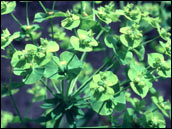

| Surge of the Leafy Spurge | |||
When the leafy spurge, a weed native to Asia, invaded the Great Plains region choking crops and making the cattle that ate it sick, farmers knew that something had to be done to stop the spread of this aggressive weed. George Seielstad, an Earth system scientist at the University of North Dakota, is leader of the Northern Great Plains regional assessment study that has been examining the consequences of climate change for agriculture, forests, grasslands, and water resources. Seielstad and his team analyzed the situation facing North Dakota, South Dakota, Wyoming, Montana, and Idaho as part of the National Assessment. The leafy spurge is not grazed or limited by predators in the United States, grows quickly (spreading out several feet a year), and has seeds that can remain in the soil for up to seven years. These attributes make the leafy spurge hard to control and eradicate. Scientists turned to satellites for help. The biggest problem was distinguishing the crops from the weeds in the remote sensing imagery. Using Landsat satellite data, scientists identified areas where leafy spurge infiltrated fields by comparing satellite images. Leafy spurge reflected a very different signal back to the satellite than the signal from fields without the weed. Once the scientists knew where the leafy spurge was present, they could plan an attack. |
 Leafy spurge is a weed that is spreading through many western states in the U.S. Farmers are concerned about the weed because it is harmful to cattle and squeezes out crops. Global warming is likely to expand leafy spurge’s range. (Photograph courtesy Robert A. Masters, University of Nebraska) | ||
There is a root-boring beetle from Europe that feeds on the leafy spurge, which benefits the crops as well as the environment. The beetle has been imported to spurge-infested areas to solve the problem. “Finding natural predators like the root-boring beetle are neat tools that are environmentally sound and help address problems that are raised by invasive species and are amplified by climate change,” says Seielstad. “We need more of these types of win-win solutions.” |
Landsat and other satellites can identify areas infested with leafy spurge from space. Land managers, ranchers, and farmers use these images to plan efforts to control the weed. In the image at left, yellow and red contours indicate leafy spurge infestations measured by Landsat. Circles with the letter “a” are areas where leafy spurge was confirmed by ground survey. Areas marked with a “b” did not contain leafy spurge. (Image courtesy Jerry Freilich, Jack States and Richard Podolsky) | ||
One of the most effective means for communicating the results of this study was for Seielstad to personally talk with farmers about the potential crop dangers in their future. “We showed farmers climate data that explained the conditions over the last 100 years,” says Seielstad. “Also, we were able to gather valuable information about the region's soil.” As a result of combining these two factors, Seielstad and his team made an impression on the farmers. “We showed farmers how they could save money on fertilizer by proving to them that their soil had plenty of nitrogen,” says Seielstad. “One husband and wife team discovered that, given the current climatic conditions, it would be more beneficial for them to destroy their crop this year in order to protect the nutrients in the soil for a better crop next year.” MacCracken stresses that society is making a lot of choices right now that will determine how we are going to be affected by future climate change. “No matter what happens with these international agreements, we are experiencing climate change now, and we will be experiencing it for many decades-we absolutely must get prepared for such changes,” says MacCracken. For more information: Metropolitan East Coast Region's website |
|